Project “Vilcha – the resettled village”: experience, impressions and perspectives
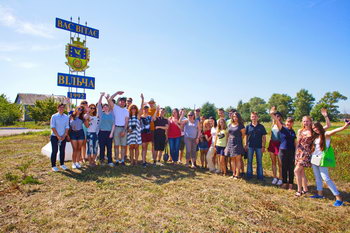
There are such events in the history, the consequences of which will be felt not by one generation. In 1986 the world faced a new thread – “invisible 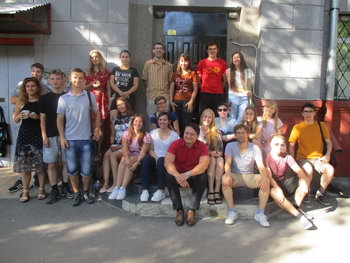 war”, the name of which was Chernobyl. This word will remain forever in the social space and, unfortunately, will be associated only with something tragic.
war”, the name of which was Chernobyl. This word will remain forever in the social space and, unfortunately, will be associated only with something tragic.
The echo of the Chernobyl catastrophe will be seen not only on the newspapers and magazines' pages; they will be heard on political stages, ecological forums and scientific symposiums. Chernobyl is not just the first technogenous catastrophe or an ecological disaster; this is a social anomaly that has changed destinies of hundred thousand people, who without any wishes have found themselves in the center of this incomprehensible and invisible “war”.
No matter what anyone says, Chernobyl, its consequences are revealing even now, especially in the time when the Ukrainian society is facing the problem of forced resettlement again. Though the reasons of this resettlement in both cases are different, their essence is the same – the loss of personal identification space, the loss of home, the breakup with the roots against the will, but under events consumption.
Indisputably, such social phenomena cause the research potential of scientists, first of all, humanitarians, the task of whom is to explain to the society the problems we are facing.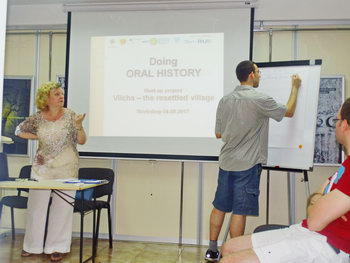
The project “Vilcha – the resettled village” was created to show the other side of Chernobyl, to understand how the peoples’ destinies are changing, to learn the personal experience of the resettlement. During 9 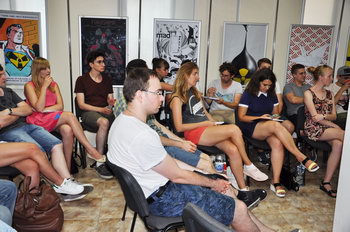 days, from the 3rd to the 11th of August 2017 the Ukrainian - German group was working on the objectives of the project. The initiative united these young researches from two countries – Germany and Ukraine, was taking by joint efforts of Chernobyl History Workshop, Ruhr-University Bochum (Germany), Ukrainian Association of Oral History within the project “MEET UP! German –Ukrainian youth encounters” under the financial support of the “Memory, responsibility, future” foundation (EVZ). It is important to gratitude to each co-organizer, thanks to whom such a necessary project is being realized.
days, from the 3rd to the 11th of August 2017 the Ukrainian - German group was working on the objectives of the project. The initiative united these young researches from two countries – Germany and Ukraine, was taking by joint efforts of Chernobyl History Workshop, Ruhr-University Bochum (Germany), Ukrainian Association of Oral History within the project “MEET UP! German –Ukrainian youth encounters” under the financial support of the “Memory, responsibility, future” foundation (EVZ). It is important to gratitude to each co-organizer, thanks to whom such a necessary project is being realized.
The objective of the project is to introduce students and young scientists to the problem of forced resettlement in Ukraine and to make a comparative analysis of the resettlement experience from the exclusion zone after the Chernobyl catastrophe and the experience of IDPs from the zone of military conflict in the East of Ukraine (2014-2017). Though, I want to point out that the moral part of this project is not less important for us. Our society not just need 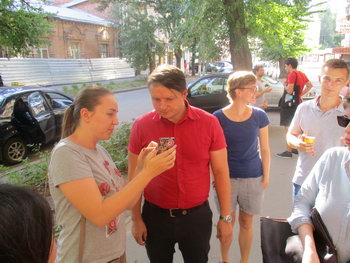 tolerance, we need the understanding. As for me, the project has become an island of comprehension. Maybe, for German group, it was not just an opportunity to understand the modern Ukraine, but to compare the Ukrainian and German experience of forced resettlement, migration.
tolerance, we need the understanding. As for me, the project has become an island of comprehension. Maybe, for German group, it was not just an opportunity to understand the modern Ukraine, but to compare the Ukrainian and German experience of forced resettlement, migration.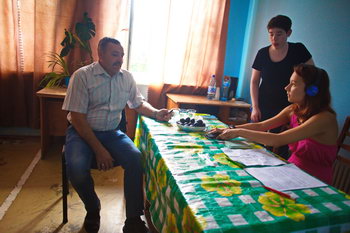
The whole project is divided into two big parts – the Ukrainian part (August 2017) and German part of the project (the beginning of 2018). The first part is theoretical and practical activities, the second – summarizing and presenting the project results. The head of the project is Viktoria Naumenko, Candidate of Historical Sciences, the head of Chernobyl Oral History Archive; the head of the Ukrainian group – Svetlana Teluha, Candidate of Historical Sciences, associate professor of the Department of Political History, National Technical University “Kharkov Polytechnic Institute”, the head of German group – Olena Petrenko, historian, the lecturer of the Department of Eastern-European History of Historic School, Ruhr-University Bochum.
The Ukrainian part of the project consisted of several modules during which the participants were forming their professional skills. The first day of the project started with an unforgettable walk around Kharkiv. Inspired by the beauty 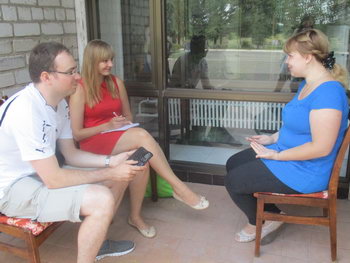 of the city, the participants started to work actively on the project in Chernobyl History Workshop. The presentation of the project has become an additional stimulus to deepen into the problematic. The participants had a meeting with the liquidators of the breakdown elimination of Chernobyl nuclear power plant. We have known about Chernobyl since school and annually we feel this tragic atmosphere at the end of April when all the news space is filled with information about terrible events happened on 26 April 1986. However, when you talk to people face to face, who took part in this “invisible war” you start to understand and comprehend this tragedy in a new way. The lesson of Chernobyl is opened; the humankind hasn’t realized it yet. That is why we should not just
of the city, the participants started to work actively on the project in Chernobyl History Workshop. The presentation of the project has become an additional stimulus to deepen into the problematic. The participants had a meeting with the liquidators of the breakdown elimination of Chernobyl nuclear power plant. We have known about Chernobyl since school and annually we feel this tragic atmosphere at the end of April when all the news space is filled with information about terrible events happened on 26 April 1986. However, when you talk to people face to face, who took part in this “invisible war” you start to understand and comprehend this tragedy in a new way. The lesson of Chernobyl is opened; the humankind hasn’t realized it yet. That is why we should not just 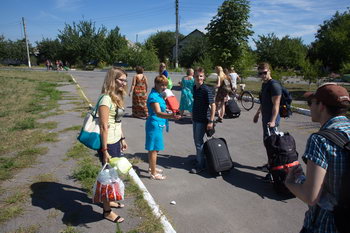 remember Chernobyl, but we have to talk about it.
remember Chernobyl, but we have to talk about it.
The researcher Gelinada Grinchenko conducted a series of lectures about oral history and specifics of oral-historical interview. All the participants were divided into 12 working groups (1 Ukrainian and 1 German representative) and in the Workshop we practiced in conducting such kind of interviewing. For most of us, it was the first experience, but it was of so great importance. And thanks to the professionalism of Gelinada Grinchenko we were ready to our “field work”.
The second theoretical module was dedicated to the creation of a documentary movie. The Ukrainian documentary film maker Dmitriy Konovalov has not just explained the process of creation of video, his words have become a motivation for the searching of ideas and their realization. I suppose 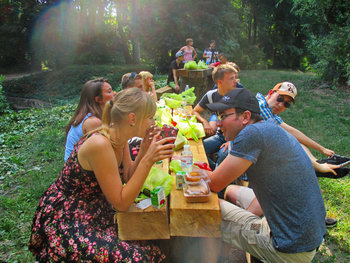 many of the participants opened their hidden talent for creating a filmography. And to consolidate the material, our working groups went along Kharkov streets “to catch the moments”. The history should not be just written, but it should be seen and heard. That is why I want to underline a good initiative of the organizer of the project to teach the participants to visualize the research. For us, historians, it is so necessary “to take the history outwards the offices” and learn how to spread the results of our past and present in a correct way.
many of the participants opened their hidden talent for creating a filmography. And to consolidate the material, our working groups went along Kharkov streets “to catch the moments”. The history should not be just written, but it should be seen and heard. That is why I want to underline a good initiative of the organizer of the project to teach the participants to visualize the research. For us, historians, it is so necessary “to take the history outwards the offices” and learn how to spread the results of our past and present in a correct way.
Theoretical modules with practical elements prepared us to our trip to Vilcha. A modern village Vilcha, Vovchansk district, Kharkiv region appeared on a map of Ukraine in 1992 in accordance with the standards of compulsory resettlement from the zone of the Chernobyl catastrophe. The old Vilcha (Poliskiy district of Kyiv region) was not in the 30-kilometer exclusion zone after the explosion, that is why it was not under the urgent evacuation. Local people had lived there for several years without understanding a real ecological situation, not knowing that one day they would leave their homes. At the beginning of 1990s a compulsory resettlement from the 50-kilometer zone started. The residents of more than 80 townships had left their homes forever. The residents of Vilcha got an opportunity to move to the fields of 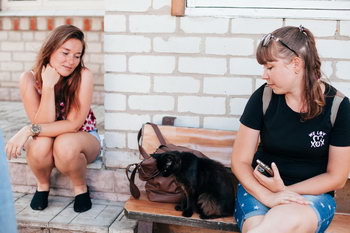 Slobozhanschyna. In this way a new Vilcha appeared.
Slobozhanschyna. In this way a new Vilcha appeared.
The participants of the project get acquainted with the village and local autonomous bodies. They visited the church of Ukrainian Greece-Catholic Church, located in one of the houses. With the help of local priest it was opened a centre of giving support for the people displaced from the zone of military conflict, in peculiar, single mothers. Several families live there today. The objective of the centre was not just to help women with children appeared in a difficult situation, but to adapt them to future. The meeting with these people was a great opportunity for the participants to compare the experiences of resettlement.
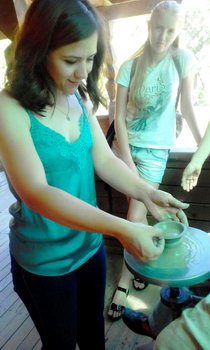 The participants of the project had lived in the families of Vilcha residents for 3 days. There they could learn much about the experience of the resettlement from the zone of ecological catastrophe. Two days passed in the atmosphere of active work and Chernobyl History Workshop Archive enriched with dozens of oral-historical interviews. Moreover, the participants prepared some video material. The material will not just become a part of the group project; these videos will keep the stories of people who had broken links with their homeland forever. Was this field work difficult for us? Probably, the biggest difficulty was in finding emotional and psychological connection with the respondents. But, I consider that we have managed to do it.
The participants of the project had lived in the families of Vilcha residents for 3 days. There they could learn much about the experience of the resettlement from the zone of ecological catastrophe. Two days passed in the atmosphere of active work and Chernobyl History Workshop Archive enriched with dozens of oral-historical interviews. Moreover, the participants prepared some video material. The material will not just become a part of the group project; these videos will keep the stories of people who had broken links with their homeland forever. Was this field work difficult for us? Probably, the biggest difficulty was in finding emotional and psychological connection with the respondents. But, I consider that we have managed to do it.
Moreover, the project agenda provided for the acquainting with famous cultural and art centres of Kharkiv and Donetsk regions. The group visited Svyatohorsk of Donetsk region (Svyatohirska lavra, Charity Foundation “Slavic heart”), Parhomivskiy historical and art museum, Krasnokytskiy arboretum, where V.N. Karazin, the founder of Kharkiv National University, had worked. These 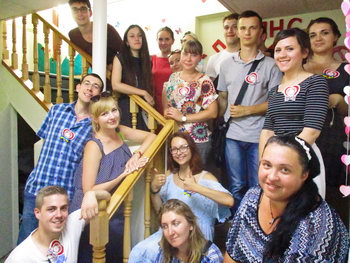 trips were not just a wonderful supplement to the project, in Svyatohirsk we communicated with the representatives of the Foundation created by people with the status of IDP. It was the first acquaintance with Slobozhanschina and Donetsk region for most of the participants from the Ukrainian group.
trips were not just a wonderful supplement to the project, in Svyatohirsk we communicated with the representatives of the Foundation created by people with the status of IDP. It was the first acquaintance with Slobozhanschina and Donetsk region for most of the participants from the Ukrainian group.
Visiting Poltava and Oposhnya village, where the participants of the project had an opportunity to get acquainted with Ukrainian culture and to make a souvenir by themselves was a symbolic finishing of the Ukrainian part of the project.
The project took place. And the most important, it let us understand that being a researcher is a hard work. But such work is necessary. Thanks to these projects not only the science will develop but also the Ukrainian society in whole.
